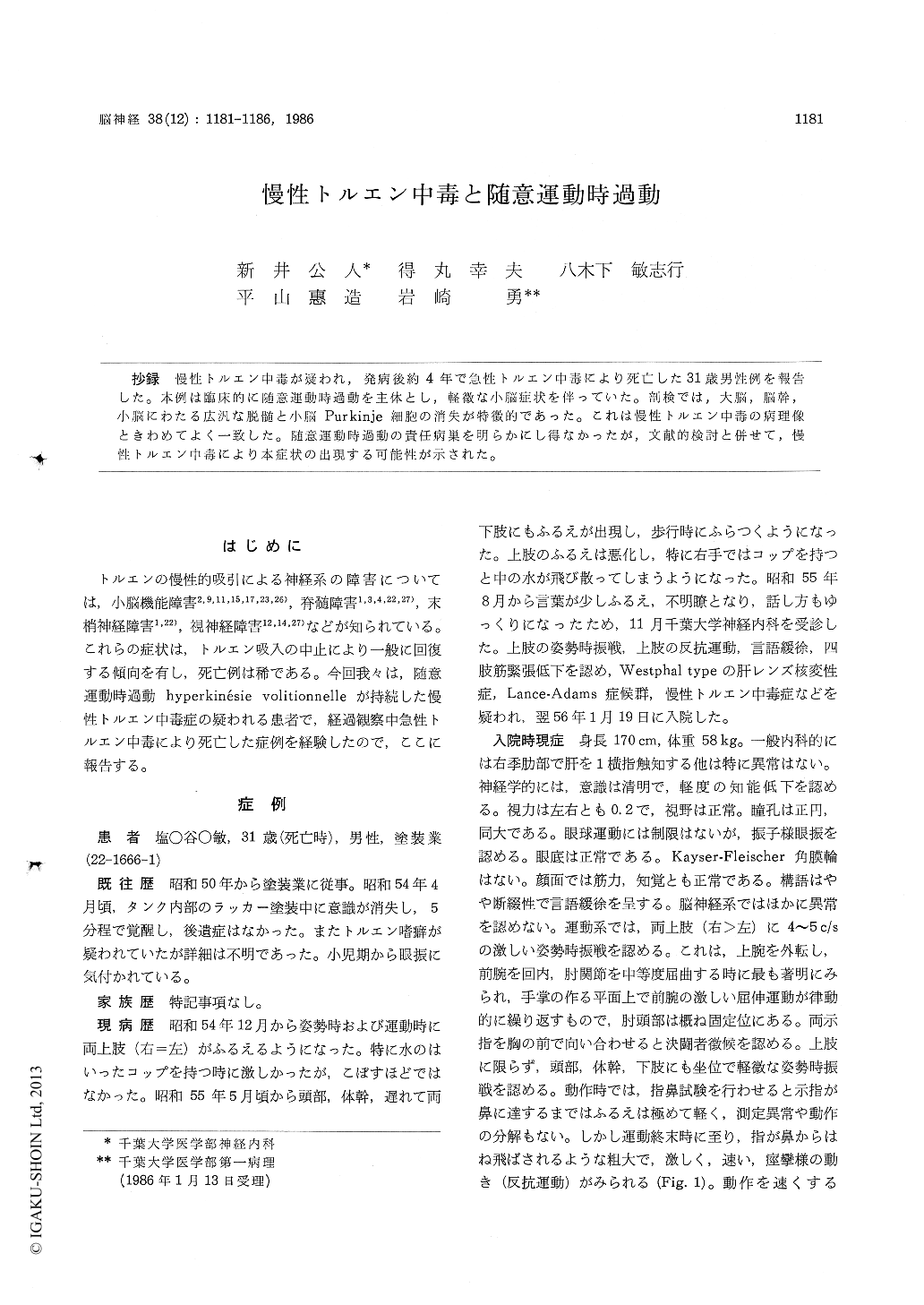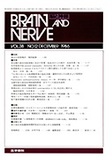Japanese
English
- 有料閲覧
- Abstract 文献概要
- 1ページ目 Look Inside
抄録 慢性トルエン中毒が疑われ,発病後約4年で急性トルエン中毒により死亡した31歳男性例を報告した。本例は臨床的に随意運動時過動を主体とし,軽微な小脳症状を伴っていた。剖検では,大脳,脳幹,小脳にわたる広汎な脱髄と小脳Purkinje細胞の消失が特徴的であった。これは慢性トルエン中毒の病理像ときわめてよく一致した。随意運動時過動の責任病巣を明らかにし得なかったが,文献的検討と併せて,慢性トルエン中毒により本症状の出現する可能性が示された。
Hyperkinésie volitionnelle is one of the involun-tary movements discriminated from intention tremor. It occurs idiopathically and with cerebral infarction, head trauma, brain tumors, multiple sclerosis, hepatolenticular degeneration and poly-neuropathy. Here, we report a case of toluene intoxication presenting hyperkinésie volitionnelle.
A 28-year-old painter noticed a tremor of the upper extremities on December 1979. The tremor occurred both in posture and in voluntary move-ments. The tremor gradually developed and appear-ed in the legs in May 1980. Slight titubation of the trunk and head was marked in sitting posture. He showed staggering of gait. On August 1980, he exhibited slurred speech. He was admit-ted to the Department of Neurology of Chiba University Hospital on January 19th, 1981.
Neurological examination revealed slight mental deterioration, pendular nystagmus, bradylalia, 4-5 c/s violent postural tremor of the upper extremi-ties, action myoclonus, head and truncal titubation, mild leg tremor in sitting posture. The tremor increased terminally on finger to nose testing, and showed fast, coarse, convulsive movement (mouve-ment oppositionniste). But there was no dysmetria. The involuntary movements, above mentioned, were summarized as hyperkinésie volitionnelle. Muscle tone was hypotonic. Muscle weakness andatrophy were not seen. Deep tendon reflexes were all exaggerated, but there was no pathological reflex. He showed wide-based ataxic gait. Sensory and autonomic functions were normal.
Blood, urine and cerebrospinal fluid analysis appeared normal. Electroencephalography showed 40-50μV, 9-10 c/s a waves with a few fast waves. Brain CT scan revealed a moderate enlargement of the lateral and third ventricles. Surface elec-tromyography was performed on the proximal musculature of the arm. 3 c/s reciprocal rhythmical grouping discharges were found at the terminal phase of the elbow bending. The tremor was diminished by 20 minutes ischemic compression test of the arm.
With respect to therapy, clonazepam was useful for hyperkinésie volitionnelle. He became able to drink a cup of water without spilling it by his own hands, and was discharged from hospital on April 3rd, 1981. It was believed that he was a habitual sniffer of toluene. On June 30th, 1983 he was found comatose. On admission to Chiba Emer-gency Medical Center, his breath smelt of toluene. His blood toluene level was 7.53 ppm, and urinary hippuric acid concentration was 9,500 mg//. He died on July 9th, 1983 because of disseminated intravascular coagulation, multiple organ failure and perforation of the terminal ileum.
Autopsy was performed and neuropathological findings were as follows.
1) Diffuse demyelination and gliosis of the cere-bral and cerebellar white matter.
2) Marked loss of Purkinje cells of the cere-bellum.
3) Astrocytic proliferation of the dentate fugal system and inferior olivary nucleus of medulla.
We thought this case was one of chronic toluene intoxication because of the history of toluene abuse, acute toluene intoxication, and pathological compatibility with a reported case. It was unclear which lesion had contributed to hyperkinésie vo-litionnelle. Toluene intoxication may represent hyperkinésie volitionnelle. So it is necessary to make a serious observation on tremor in cases of chronic toluene intoxication.

Copyright © 1986, Igaku-Shoin Ltd. All rights reserved.


